Page 539 of 618
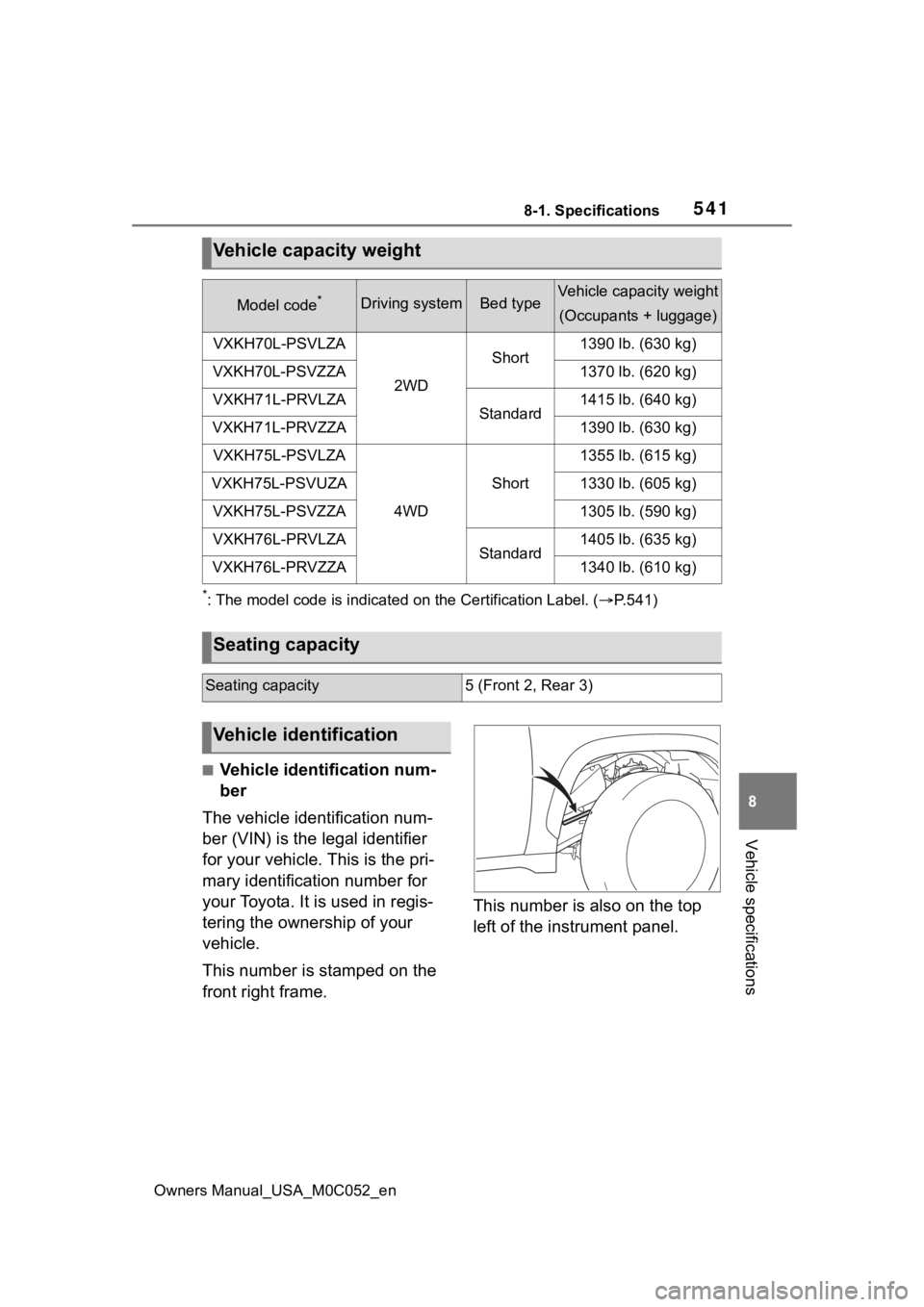
5418-1. Specifications
Owners Manual_USA_M0C052_en
8
Vehicle specifications
*: The model code is indicated on the Certification Label. (P.541)
■Vehicle identification num-
ber
The vehicle identification num-
ber (VIN) is the legal identifier
for your vehicle. This is the pri-
mary identification number for
your Toyota. It is used in regis-
tering the ownership of your
vehicle.
This number is stamped on the
front right frame. This number is also on the top
left of the instrument panel.
Vehicle capacity weight
Model code*Driving systemBed typeVehicle capacity weight
(Occupants + luggage)
VXKH70L-PSVLZA
2WD
Short1390 lb. (630 kg)
VXKH70L-PSVZZA1370 lb. (620 kg)
VXKH71L-PRVLZAStandard1415 lb. (640 kg)
VXKH71L-PRVZZA1390 lb. (630 kg)
VXKH75L-PSVLZA
4WD
Short
1355 lb. (615 kg)
VXKH75L-PSVUZA1330 lb. (605 kg)
VXKH75L-PSVZZA1305 lb. (590 kg)
VXKH76L-PRVLZAStandard1405 lb. (635 kg)
VXKH76L-PRVZZA1340 lb. (610 kg)
Seating capacity
Seating capacity5 (Front 2, Rear 3)
Vehicle identification
Page 553 of 618
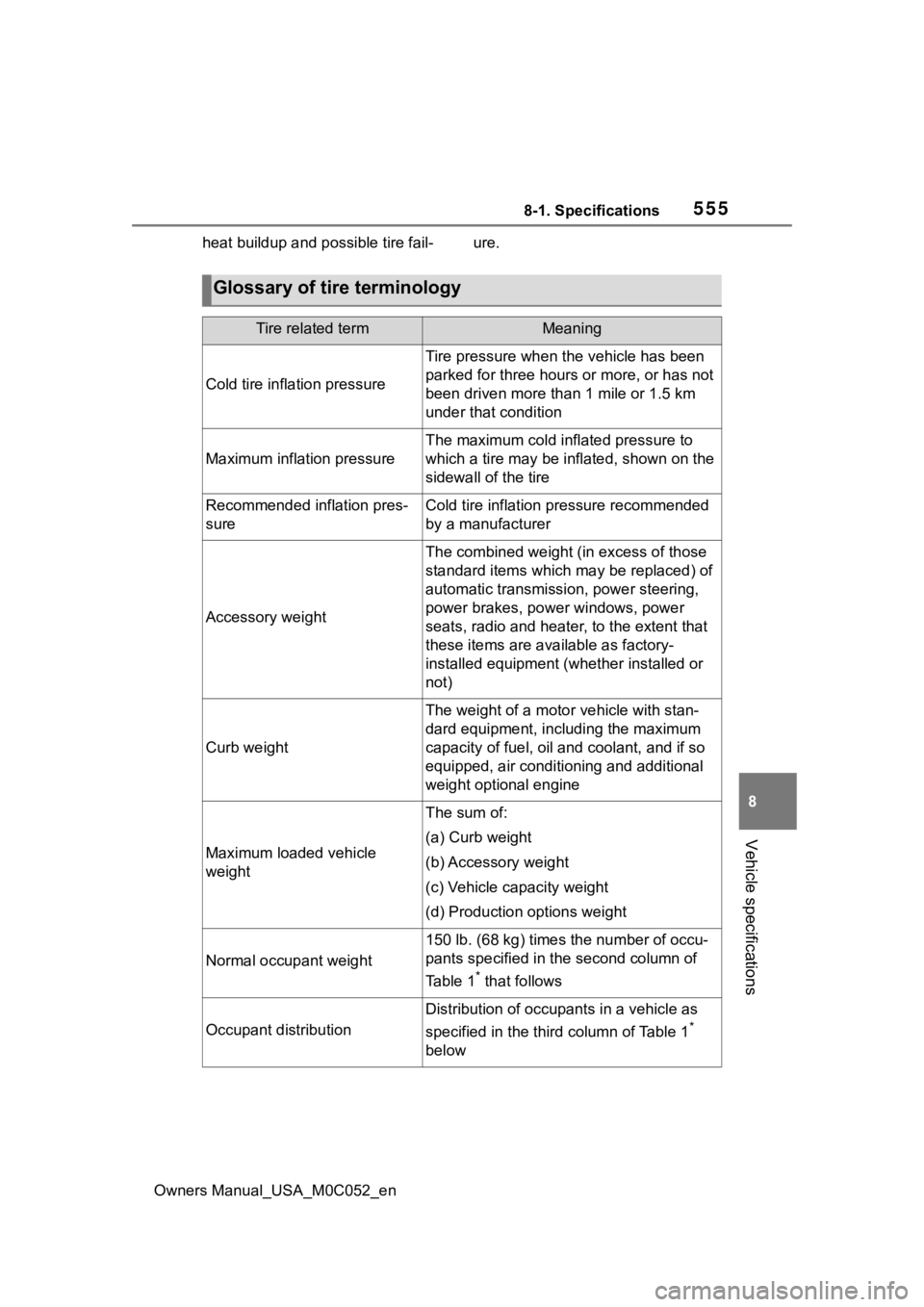
5558-1. Specifications
Owners Manual_USA_M0C052_en
8
Vehicle specifications
heat buildup and possible tire fail- ure.
Glossary of tire terminology
Tire related termMeaning
Cold tire inflation pressure
Tire pressure when the vehicle has been
parked for three hours or more, or has not
been driven more than 1 mile or 1.5 km
under that condition
Maximum inflation pressure
The maximum cold inf lated pressure to
which a tire may be inflated, shown on the
sidewall of the tire
Recommended inflation pres-
sureCold tire inflation pressure recommended
by a manufacturer
Accessory weight
The combined weight (in excess of those
standard items which may be replaced) of
automatic transmission, power steering,
power brakes, power windows, power
seats, radio and heater, to the extent that
these items are ava ilable as factory-
installed equipment (whether installed or
not)
Curb weight
The weight of a moto r vehicle with stan-
dard equipment, including the maximum
capacity of fuel, oil and coolant, and if so
equipped, air conditioning and additional
weight optional engine
Maximum loaded vehicle
weight
The sum of:
(a) Curb weight
(b) Accessory weight
(c) Vehicle capacity weight
(d) Production options weight
Normal occupant weight
150 lb. (68 kg) times the number of occu-
pants specified in the second column of
Ta b l e 1
* that follows
Occupant distribution
Distribution of occupants in a vehicle as
specified in the third column of Table 1
*
below
Page 554 of 618
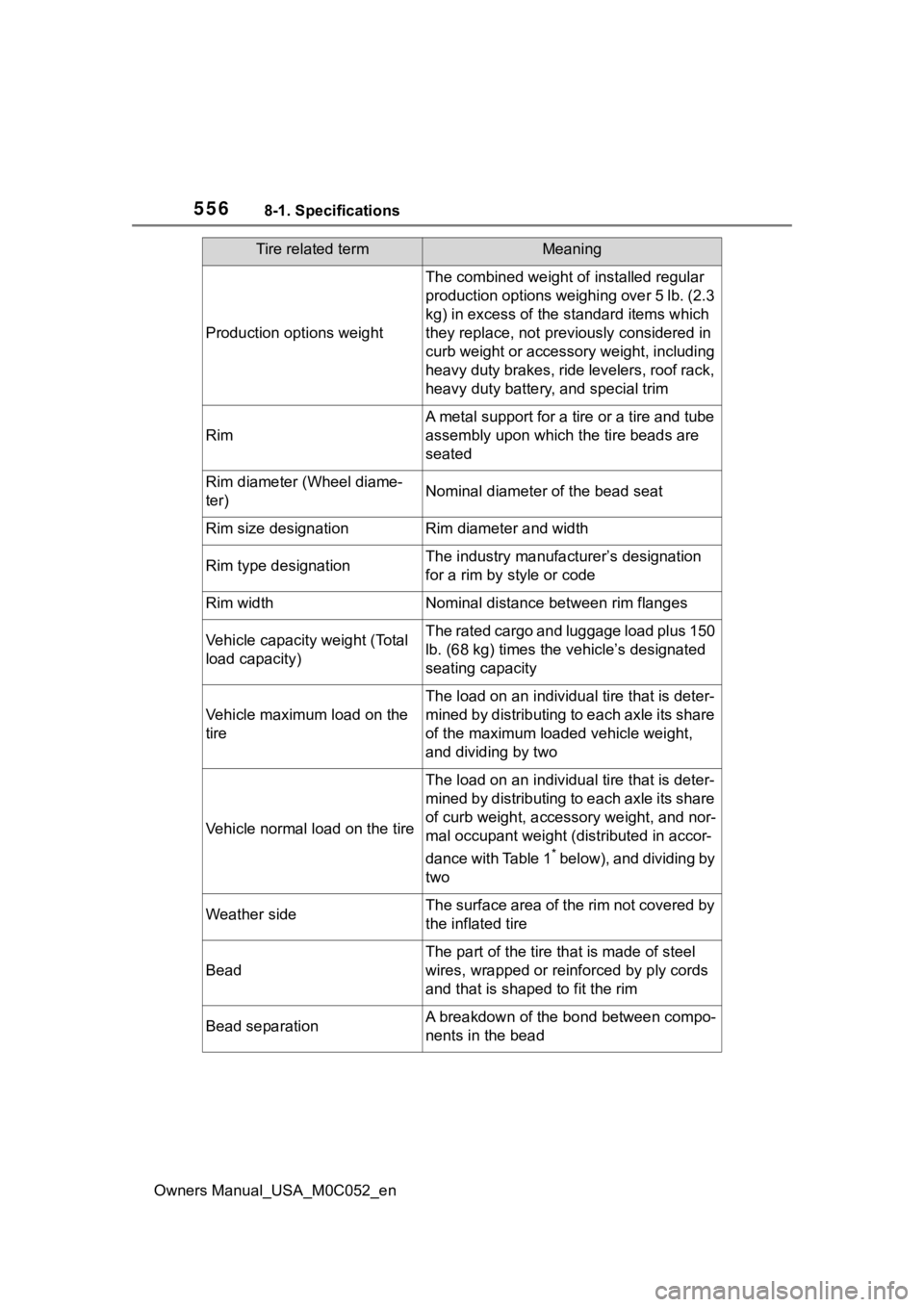
5568-1. Specifications
Owners Manual_USA_M0C052_en
Production options weight
The combined weight of installed regular
production options weighing over 5 lb. (2.3
kg) in excess of the standard items which
they replace, not previously considered in
curb weight or accessory weight, including
heavy duty brakes, ride levelers, roof rack,
heavy duty battery, and special trim
Rim
A metal support for a tire or a tire and tube
assembly upon which the tire beads are
seated
Rim diameter (Wheel diame-
ter)Nominal diameter of the bead seat
Rim size designationRim diameter and width
Rim type designationThe industry manufacturer’s designation
for a rim by style or code
Rim widthNominal distance between rim flanges
Vehicle capacity weight (Total
load capacity)The rated cargo and luggage load plus 150
lb. (68 kg) times the vehicle’s designated
seating capacity
Vehicle maximum load on the
tire
The load on an individua l tire that is deter-
mined by distributing to each axle its share
of the maximum loaded vehicle weight,
and dividing by two
Vehicle normal load on the tire
The load on an individua l tire that is deter-
mined by distributing to each axle its share
of curb weight, accessory weight, and nor-
mal occupant weight (distributed in accor-
dance with Table 1
* below), and dividing by
two
Weather sideThe surface area of the rim not covered by
the inflated tire
Bead
The part of the tire that is made of steel
wires, wrapped or reinforced by ply cords
and that is shaped to fit the rim
Bead separationA breakdown of the bond between compo-
nents in the bead
Tire related termMeaning
Page 556 of 618
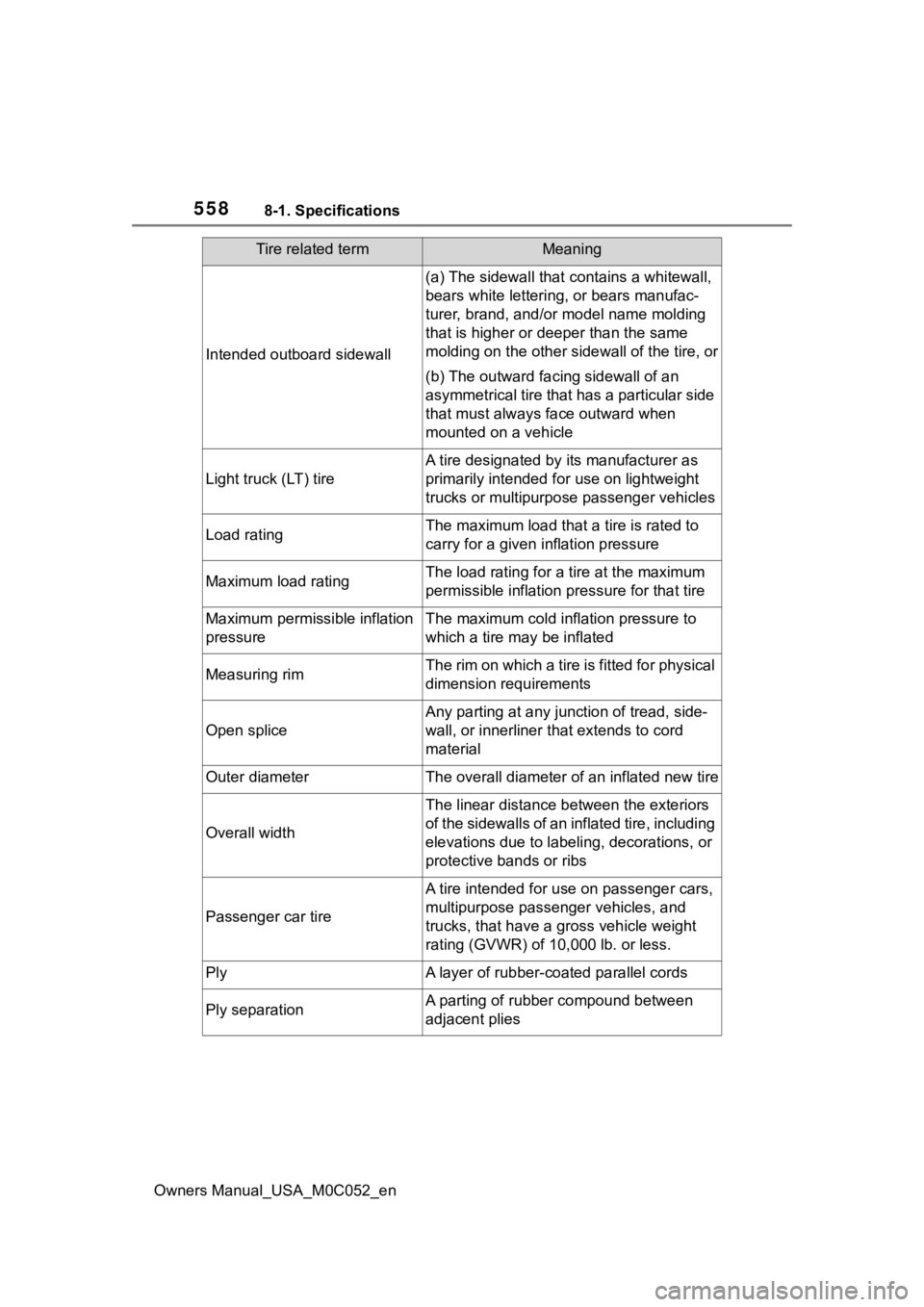
5588-1. Specifications
Owners Manual_USA_M0C052_en
Intended outboard sidewall
(a) The sidewall that contains a whitewall,
bears white lettering , or bears manufac-
turer, brand, and/or model name molding
that is higher or deeper than the same
molding on the other s idewall of the tire, or
(b) The outward facing sidewall of an
asymmetrical tire that has a particular side
that must always face outward when
mounted on a vehicle
Light truck (LT) tire
A tire designated by its manufacturer as
primarily intended for use on lightweight
trucks or multipurpose passenger vehicles
Load ratingThe maximum load that a tire is rated to
carry for a given inflation pressure
Maximum load ratingThe load rating for a tire at the maximum
permissible inflation pressure for that tire
Maximum permissible inflation
pressureThe maximum cold inf lation pressure to
which a tire may be inflated
Measuring rimThe rim on which a tire is fitted for physical
dimension requirements
Open splice
Any parting at any junction of tread, side-
wall, or innerliner that extends to cord
material
Outer diameterThe overall diameter of an inflated new tire
Overall width
The linear distance between the exteriors
of the sidewalls of an inflated tire, including
elevations due to labeling, decorations, or
protective bands or ribs
Passenger car tire
A tire intended for use on passenger cars,
multipurpose passenger vehicles, and
trucks, that have a gross vehicle weight
rating (GVWR) of 10,000 lb. or less.
PlyA layer of rubber-coated parallel cords
Ply separationA parting of rubber compound between
adjacent plies
Tire related termMeaning
Page 569 of 618

5718-3. Initialization
Owners Manual_USA_M0C052_en
8
Vehicle specifications
8-3.Initialization
*: If equipped
Items to initialize
The following items must be initialized for normal system
operation after such cases as the 12-volt battery being recon-
nected, or maintenance being performed on the vehicle:
List of items to initialize
ItemWhen to initializeReference
PKSB (Parking
Support Brake)• After reconnecting or changing the 12-volt batteryP.292
Maintenance
required reminder
message• After the maintenance is per-formedP.449, 459
Tire pressure warn-
ing system
• When the tire inflation pressure is changed, such as when
changing traveling speed or load
weight.
• When the tire inflation pressure is changed, such as when the
tire size is changed.
• When rotating the tires.
• After performing the transmitter
ID code registration procedure.
P.470
Toyota parking
assist monitor
*• 12-volt battery has been rein-
stalled.
• The steering wheel has been moved while the 12-volt battery
was being reinstalled.
• 12-volt battery power is low.
P.307, 341, 354Panoramic view
monitor
*
Multi-terrain Moni-
tor
*
Page 583 of 618
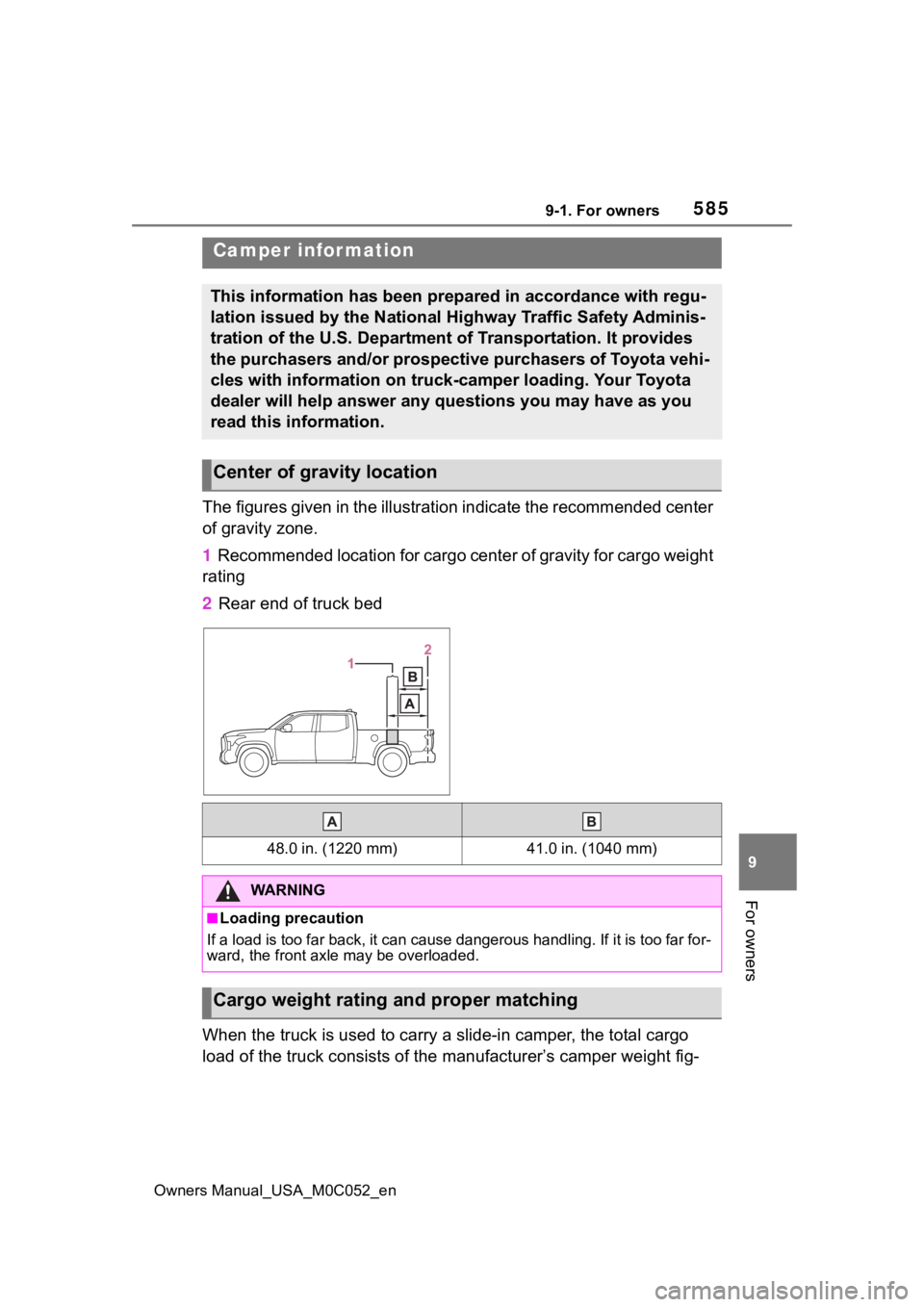
5859-1. For owners
Owners Manual_USA_M0C052_en
9
For owners
The figures given in the illustra tion indicate the recommended center
of gravity zone.
1 Recommended location for cargo center of gravity for cargo wei ght
rating
2 Rear end of truck bed
When the truck is used to carry a slide-in camper, the total cargo
load of the truck consists of the manufacturer’s camper weight fig-
Camper information
This information has been prepared in accordance with regu-
lation issued by the National Highway Traffic Safety Adminis-
tration of the U.S. Department of Transportation. It provides
the purchasers and/or prospective purchasers of Toyota vehi-
cles with information on truck-camper loading. Your Toyota
dealer will help answer any questions you may have as you
read this information.
Center of gravity location
48.0 in. (1220 mm)41.0 in. (1040 mm)
WARNING
■Loading precaution
If a load is too far back, it can cause dangerous handling. If it is too far for-
ward, the front axle may be overloaded.
Cargo weight rating and proper matching
Page 584 of 618
5869-1. For owners
Owners Manual_USA_M0C052_en
ure, the weight of installed additional camper equipment not included
in the manufacturer’s camper wei ght figure, the weight of camper
cargo, and the weight of passengers in the camper. The total ca rgo
load should not exceed the truck’ s cargo weight rating and the
camper’s center of gravity should fall within the truck’s recom -
mended center of gravity zone when installed.
Recommended center of
gravity location zone
Camper center of gravity
■Cargo weight rating
No.Model code*CabDriveBedGrade
Pas-sen- gerCargo Weight Rating
lbskg
1VXKH70L-PSVLZA
CrewMax
2WD
Short
Lim-ited
5
640290
2VXKH70L- PSVZZAPlati-num620280
3VXKH71L- PRVLZA
Stan-dard
Lim-ited665300
4VXKH71L- PRVZZAPlati-num640290
5VXKH75L- PSVLZA
4WD
Short
Lim-ited605275
6VXKH75L- PSVUZACap-
stone580265
7VXKH75L- PSVZZAPlati-num555250
8VXKH76L- PRVLZA
Stan-dard
Lim-ited655295
9VXKH76L- PRVZZAPlati-num590270
Page 585 of 618
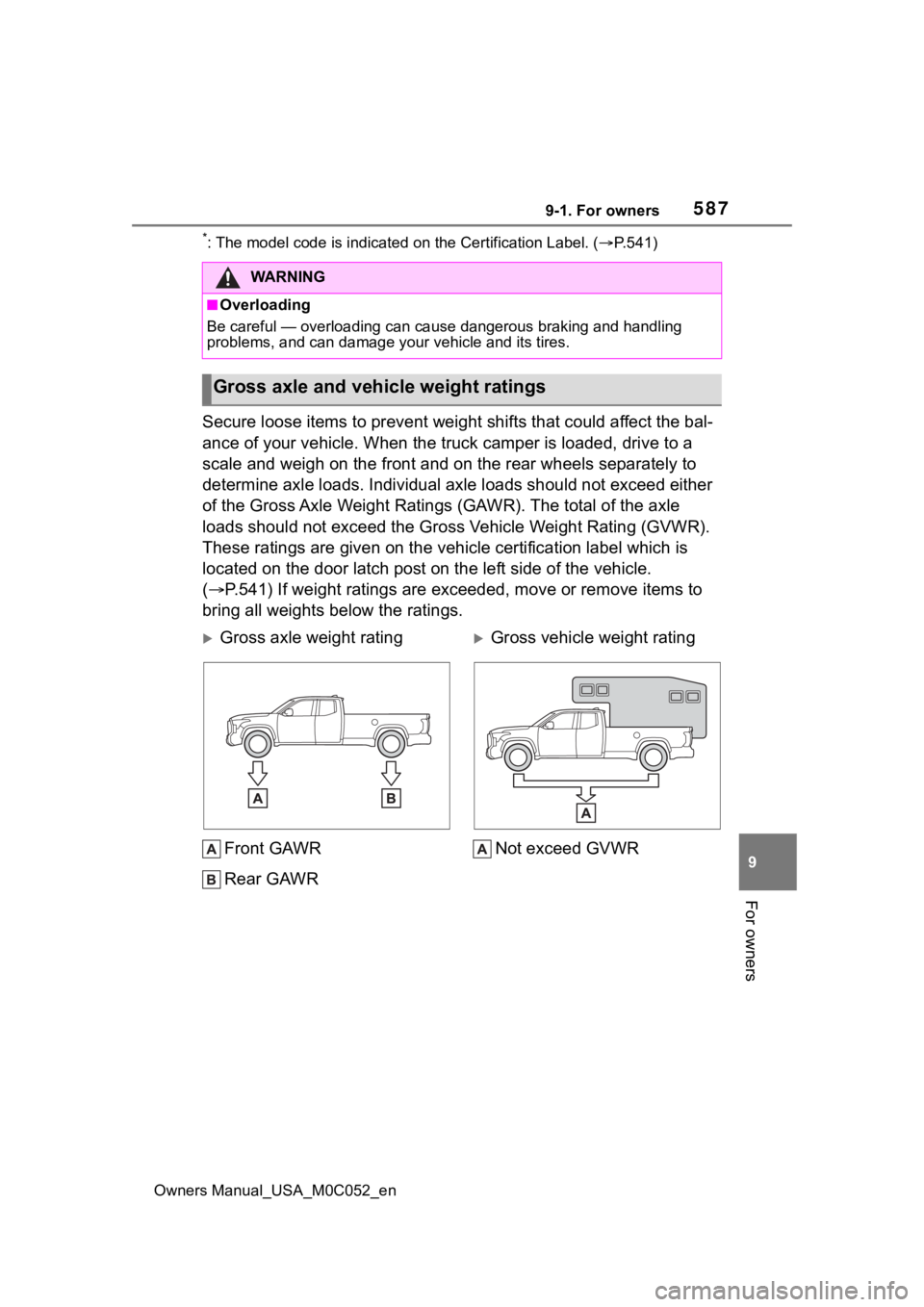
5879-1. For owners
Owners Manual_USA_M0C052_en
9
For owners
*: The model code is indicated on the Certification Label. (P.541)
Secure loose items to prevent w eight shifts that could affect the bal-
ance of your vehicle. When the truck camper is loaded, drive to a
scale and weigh on the front and on the rear wheels separately to
determine axle loads. Individual axle loads should not exceed either
of the Gross Axle Weight Ratings (GAWR). The total of the axle
loads should not exceed the Gross Vehicle Weight Rating (GVWR).
These ratings are given on the vehicle certification label whic h is
located on the door latch post on the left side of the vehicle.
( P.541) If weight ratings are exce eded, move or remove items to
bring all weights below the ratings.
Gross axle weight rating
Front GAWR
Rear GAWRGross vehicle weight ratingNot exceed GVWR
WARNING
■Overloading
Be careful — overloading can cause dangerous braking and handli ng
problems, and can damage your vehicle and its tires.
Gross axle and vehicle weight ratings